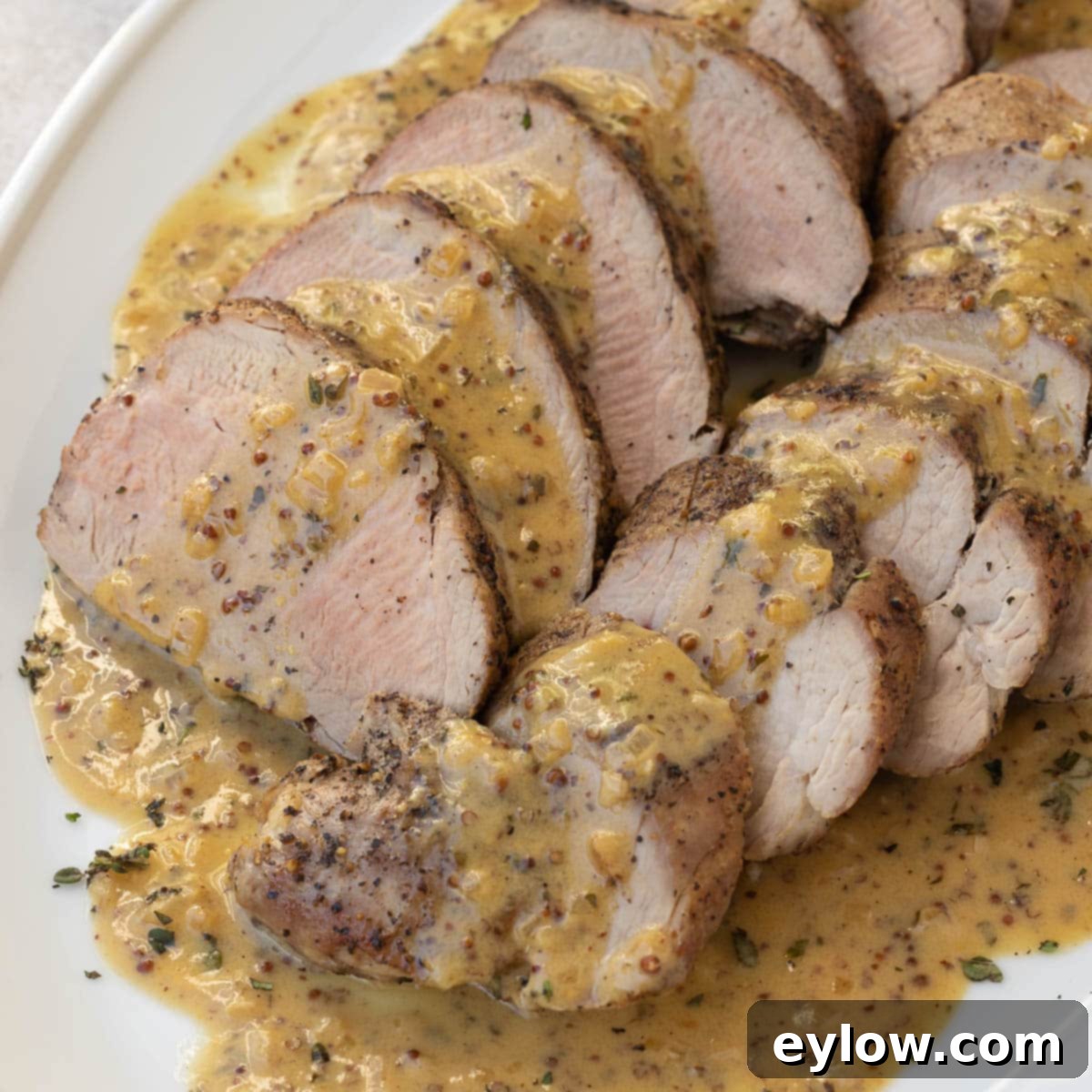Effortlessly Elegant: Quick & Juicy Roast Pork Tenderloin with Creamy Dijon Mustard Sauce
Discover the ultimate dinner solution with this incredible roast pork tenderloin, featuring a rich and savory Dijon mustard sauce. This recipe delivers everything you could wish for in a main course: it’s incredibly tender, wonderfully juicy, bursting with flavor, and astonishingly ready in just 30 minutes. The pork tenderloin roasts beautifully in the oven, creating a perfectly cooked main dish, while the creamy Dijon sauce adds a delightful tang and depth that complements the pork’s mild sweetness with every bite. Whether you’re seeking a fast and delicious weeknight meal for your family or planning to impress guests at your next gathering, this easy pork tenderloin recipe is a guaranteed crowd-pleaser that combines simplicity with sophisticated flavors.
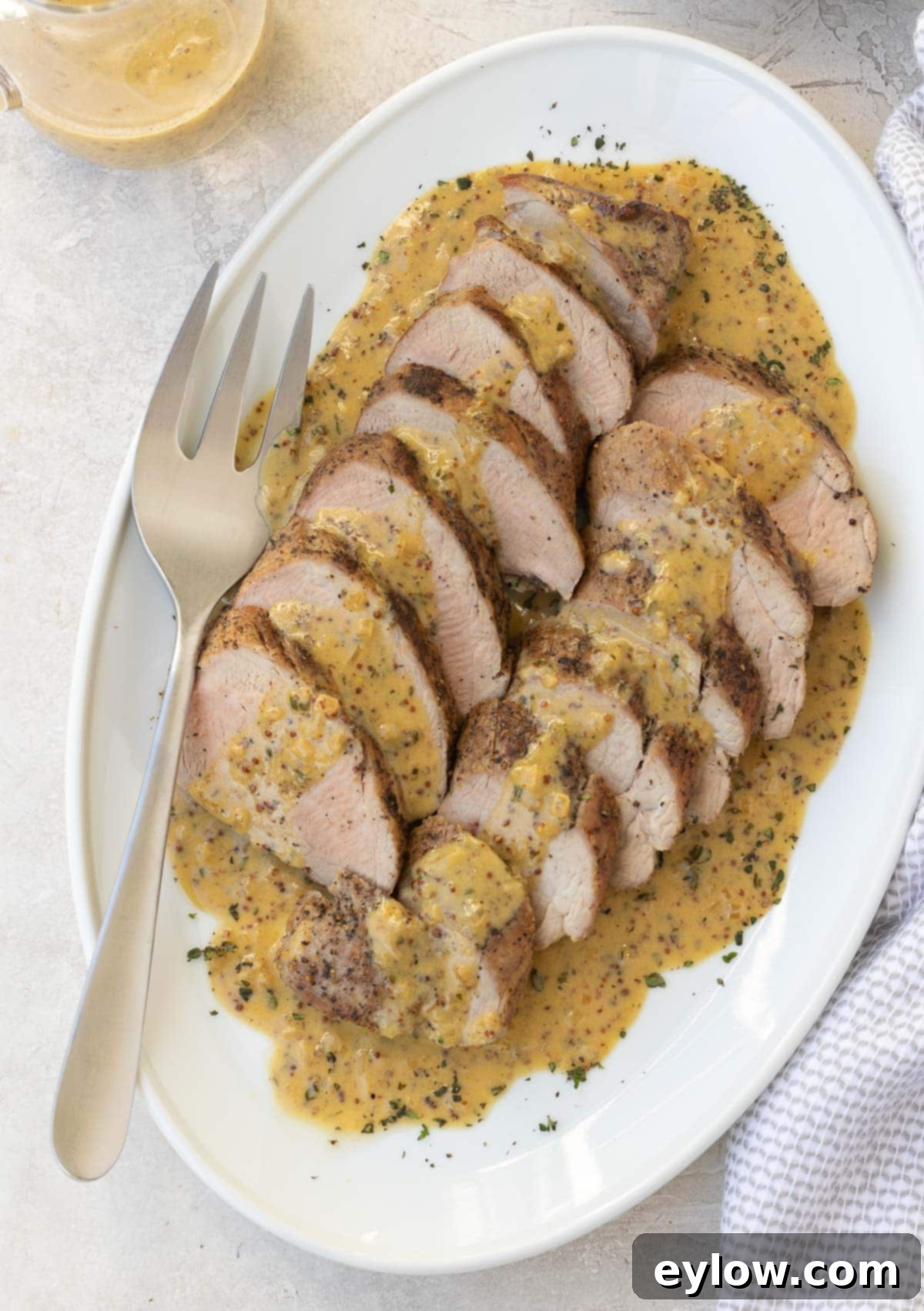
Pork tenderloin is truly one of my most cherished cuts of meat. It stands out for its quick cooking time, inherent tenderness, and remarkable versatility, adapting effortlessly to various culinary styles and flavor profiles. In this particular dish, it truly shines, especially when paired with a vibrant sauce like Dijon mustard. Dijon isn’t just a condiment in my pantry; it’s a flavor powerhouse (I often keep 2-3 jars on hand!). Its bold, tangy notes not only infuse the dish with incredible taste but also naturally thicken into a luscious, velvety sauce, transforming this simple roast pork tenderloin into a 30-minute dinner that feels both effortlessly easy and remarkably elegant. This recipe proves that you don’t need hours in the kitchen to create a meal that tastes like it came from a gourmet restaurant.
Beyond its speed and flavor, pork tenderloin is also a fantastic lean protein choice, making this dish a healthy yet indulgent option for any occasion. The combination of perfectly seared and roasted pork with a homemade creamy Dijon sauce elevates it far beyond a typical weeknight dinner, proving that convenience and gourmet quality can indeed go hand-in-hand.
[feast_advanced_jump_to]
Why You’ll Love This Roast Pork Tenderloin with Dijon Sauce
There are countless reasons to fall in love with this roast pork tenderloin recipe, making it a go-to for busy weeknights and special occasions alike. Here are the top benefits that will make this dish a staple in your culinary repertoire:
- Ready in 30 Minutes: This is a game-changer! From prep to plate, you can have a gourmet-quality meal on the table in just half an hour, making it perfect for those hectic weeknights when time is of the essence, or when you need a quick yet impressive dish for unexpected guests.
- Tender and Juicy Perfection: The unique sear-then-roast method ensures that your pork tenderloin is beautifully browned and flavorful on the outside, while remaining incredibly tender, moist, and juicy on the inside. No more dry pork – just succulent, melt-in-your-mouth perfection every time.
- Luscious Dijon Mustard Sauce: This isn’t just any sauce. Crafted with white wine, aromatic fresh herbs, and a touch of cream, it’s a velvety, tangy, and deeply savory accompaniment that elevates the entire dish. The Dijon adds a complex, vibrant flavor that perfectly balances the rich pork.
- Elegant & Impressive: Despite its simplicity and speed, this dish looks and tastes like something you’d order at a fine dining restaurant. It’s perfect for entertaining, offering an air of sophistication without any of the stress.
- Healthy and Lean: Pork tenderloin is a wonderfully lean cut of meat, providing excellent protein without excess fat. This recipe allows you to enjoy a hearty and satisfying meal that aligns with a balanced diet.
If you’re a true enthusiast of pork, I highly recommend exploring other delightful recipes like this beautiful, holiday-worthy pistachio crusted pork rib roast for a show-stopping meal, or this flavorful smoked pork tenderloin if you have access to a pellet grill or smoker and want to infuse your pork with irresistible smoky notes.
Essential Ingredients for Your Roast Pork Tenderloin
Crafting this succulent roast pork tenderloin with Dijon mustard sauce relies on a few high-quality, fresh ingredients. Each component plays a crucial role in building the rich, balanced flavors of this memorable dish.
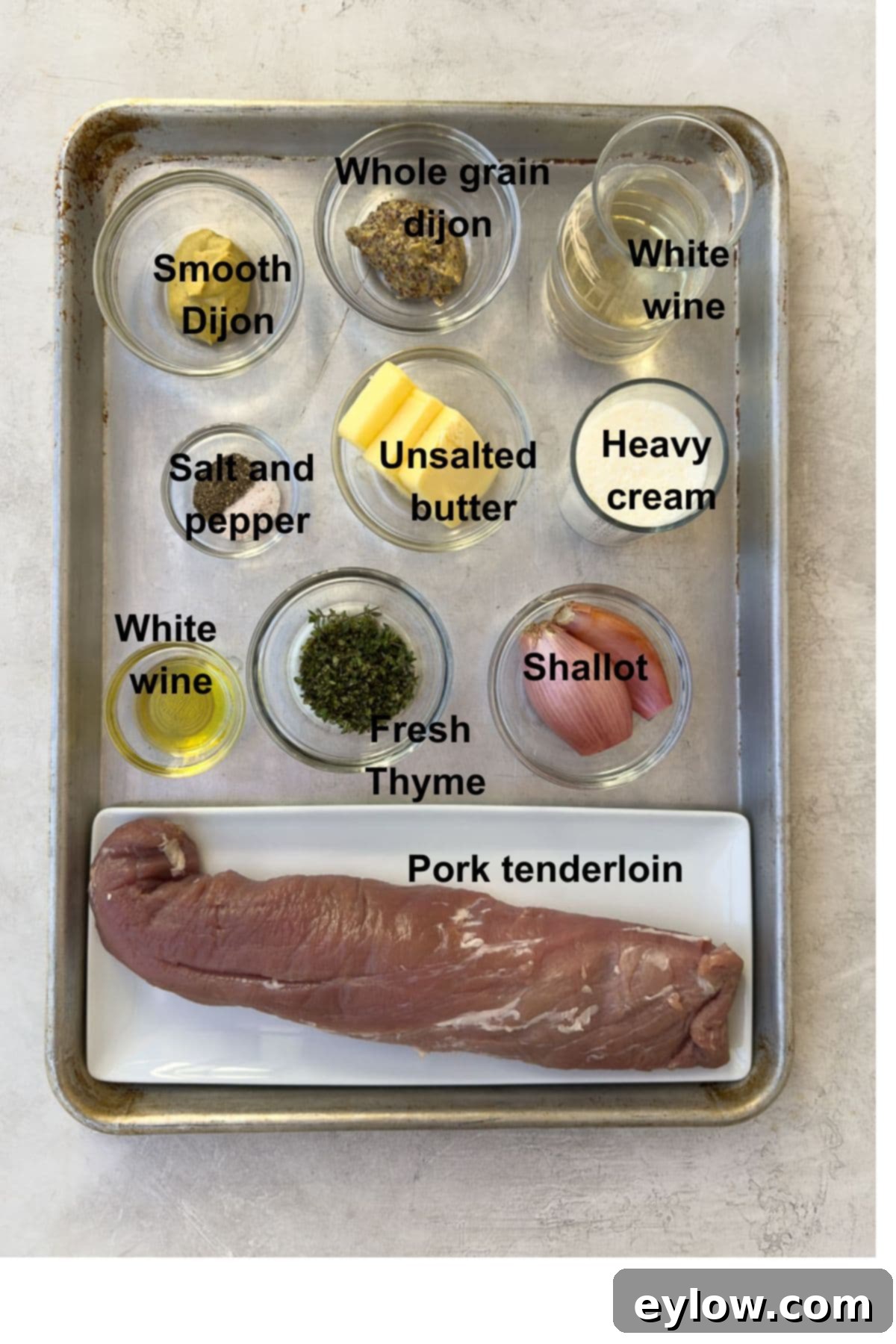
- Pork Tenderloin: This is the star of our dish. Look for a lean, boneless cut, typically weighing around 1 to 1.5 pounds. It might also be labeled as pork fillet or pork medallions (if pre-sliced). Its inherent tenderness makes it ideal for quick cooking methods like searing and roasting.
- Oil: A good quality oil is essential for searing the pork to a beautiful golden brown. Olive oil, avocado oil, or another neutral, high-smoke-point oil work exceptionally well. The oil creates a delicious crust and prevents sticking.
- Butter: Unsalted butter is preferred here, allowing you complete control over the salt levels in your sauce. It contributes a rich, creamy base and a luxurious mouthfeel to the Dijon sauce, enhancing its overall flavor.
- Heavy Cream: This ingredient is vital for achieving that rich, silky smooth texture in your Dijon mustard sauce. Opt for heavy cream or heavy whipping cream (they are essentially the same). The higher fat content is key to a truly decadent and stable sauce that won’t curdle.
- White Wine: A dry white wine, such as Sauvignon Blanc or Chardonnay, is crucial for deglazing the pan. This process involves scraping up all the flavorful browned bits (fond) left after searing the pork, incorporating them into the sauce for incredible depth. If you don’t have a full bottle, dry white vermouth is an excellent, shelf-stable alternative, and mini bottles are perfect for cooking to avoid opening a larger one.
- Shallot: With a flavor profile milder and sweeter than a regular onion, shallots are a classic element in French cooking. Finely chopped, they add both subtle depth and a delicate texture to the creamy mustard sauce, creating an aromatic foundation.
- Dijon Mustard: For the most balanced and complex sauce, you’ll need two kinds of Dijon mustard. Creamy Dijon provides the foundational body and tangy flavor, while whole-grain Dijon adds a delightful rustic texture and a subtle bite. I personally prefer authentic French brands for their superior quality and flavor.
- Fresh Herbs: Thyme is an ideal pairing for pork and mustard, offering an earthy, aromatic note. Rosemary is another excellent choice if you prefer its distinctive fragrance. While fresh herbs are always recommended for their vibrant flavor, dried thyme (use about one-third the amount of fresh) is a perfectly acceptable fallback option.
Precise measurements for each ingredient can be found in the detailed recipe card below. For those who enjoy an extra layer of moisture and flavor, consider using my pork brine recipe a few hours or overnight before cooking. Brining helps the pork retain moisture and seasoning, resulting in an even more succulent final product.
Chef’s Tip – Pork Tenderloin vs. Pork Loin (Roast)
It’s essential to understand the distinction between pork tenderloin and pork loin, as they are different cuts of meat from different parts of the animal and require different cooking approaches. Pork tenderloin is a long, thin, boneless cut, very lean, and typically weighs about 1 pound. It cooks very quickly and remains tender without needing an extra fat layer. In contrast, pork loin roasts are much larger, weighing between 2 to 5 pounds, and can be bone-in or boneless, often featuring a significant fat cap. Pork loins are generally less expensive and require longer cooking times due to their size and fat content. For this quick-cooking recipe, pork tenderloin is the ideal choice due to its inherent tenderness and ability to cook rapidly.
If you appreciate the exceptional tenderness and lean profile of tenderloin as a cut of meat, you might also enjoy this slow-roasted beef tenderloin, which is another magnificent option for special occasions or an indulgent dinner.
Substitutions and Creative Variations
While this recipe is perfect as written, it’s also incredibly versatile, allowing for several substitutions and variations to suit your dietary needs, preferences, or what you have on hand. Don’t be afraid to experiment!
- Wine Substitutions: If you prefer to cook without alcohol or simply don’t have white wine available, there are excellent alternatives. You can easily swap the wine for a good quality, low-sodium chicken broth or vegetable stock. These options will still provide depth and savory notes. For a touch of acidity and brightness, similar to what wine offers, try using apple cider vinegar diluted with an equal amount of water (a half-and-half ratio) or fresh lemon juice mixed with water in the same proportion. These acidic elements help deglaze the pan and cut through the richness of the sauce without adding alcohol. For a more comprehensive guide to creative swaps, explore this guide to wine substitutes in cooking.
- Mustard Variations: The original recipe calls for both creamy and whole-grain Dijon mustard for a balance of smooth texture and rustic bite. If you prefer a completely smooth, less textured Dijon cream sauce, simply use all creamy Dijon mustard. To achieve a balanced flavor, use just under double the amount of creamy Dijon that the recipe specifies for the creamy variety. Conversely, if you love a bolder, more pronounced mustard texture, you could slightly increase the whole-grain Dijon.
- Herb Variations: While thyme is classic, fresh rosemary, sage, or even a mix of fresh parsley and chives can lend different aromatic profiles to the sauce.
- Cream Alternatives: For a dairy-free option, you could experiment with full-fat coconut milk (canned) or a cashew cream, though these will alter the flavor profile significantly. Always taste and adjust seasoning accordingly.
- Spice It Up: A pinch of red pepper flakes added with the shallots can introduce a subtle warmth and kick to the sauce.
How to Perfectly Roast Pork Tenderloin with Creamy Dijon Sauce
Achieving a juicy, flavorful roast pork tenderloin with a stunning golden crust is simpler than you might think. This method combines searing on the stovetop with a quick finish in the oven, ensuring tender results every time. Follow these steps for an outstanding meal:
Preparation is Key: Begin by removing your pork tenderloin from the refrigerator about an hour before you plan to cook. This allows it to come closer to room temperature, promoting more even roasting and preventing the meat from seizing up when it hits the hot pan. While the pork rests, pre-heat your oven to 375°F (190°C). Carefully trim any “silver skin” (a tough, silvery membrane that doesn’t render down when cooked) and excess fat from the pork tenderloin using a sharp knife. This step ensures a more tender bite. Position a large, heavy-bottomed frying pan (cast iron or stainless steel works best) over medium to medium-high heat on your stovetop.
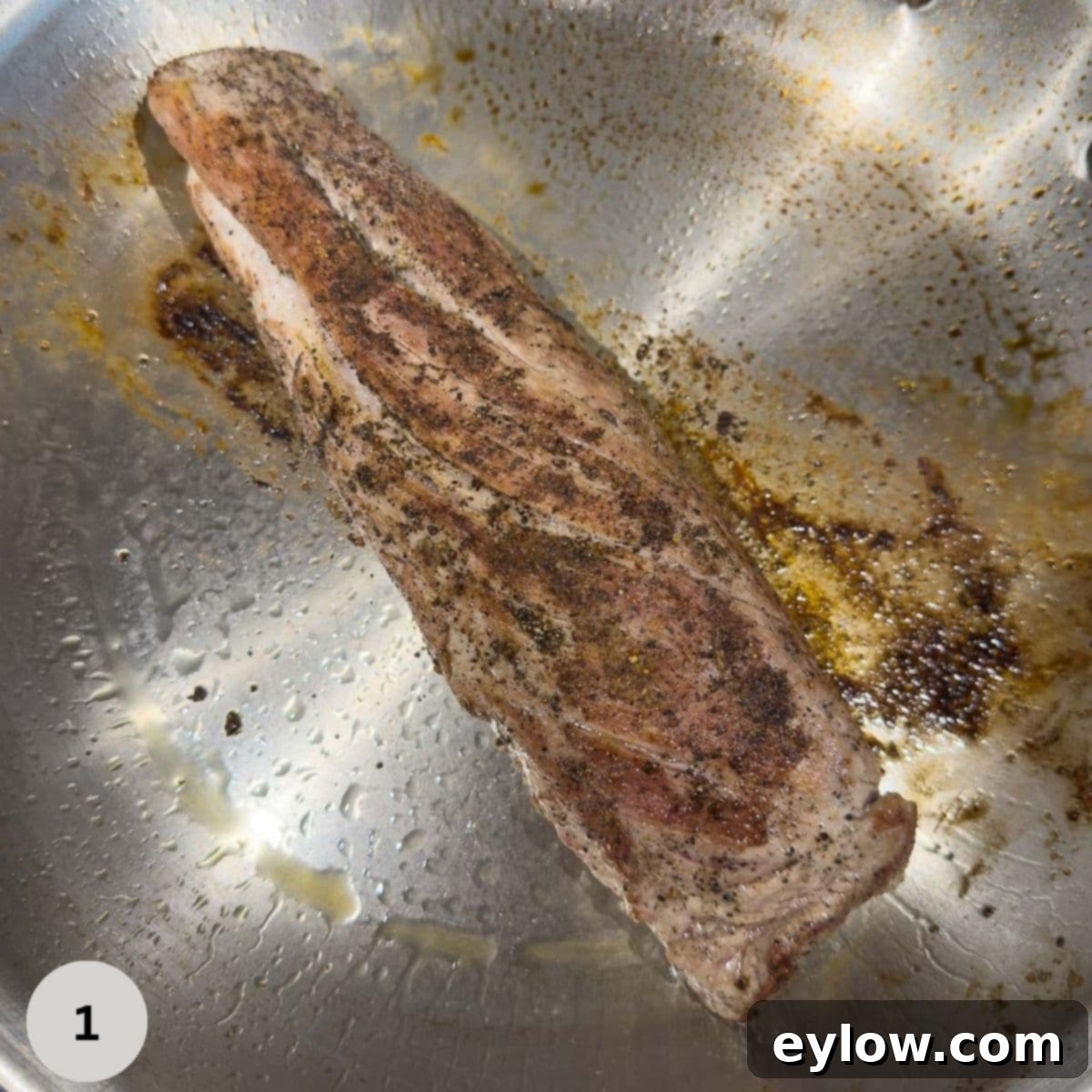
- Sear for Flavor: Generously season the pork tenderloin on all sides with sea salt and freshly ground black pepper. Once your pan is hot, add about half a tablespoon of oil (from the divided use) to coat the bottom. Carefully place the seasoned pork into the hot pan. You should hear an immediate sizzle, indicating the pan is at the right temperature for a perfect sear. Sear the pork on all sides, turning it occasionally with tongs to achieve an even, golden-brown crust. This process, known as the Maillard reaction, develops incredible savory flavors, and typically takes about 5-7 minutes.
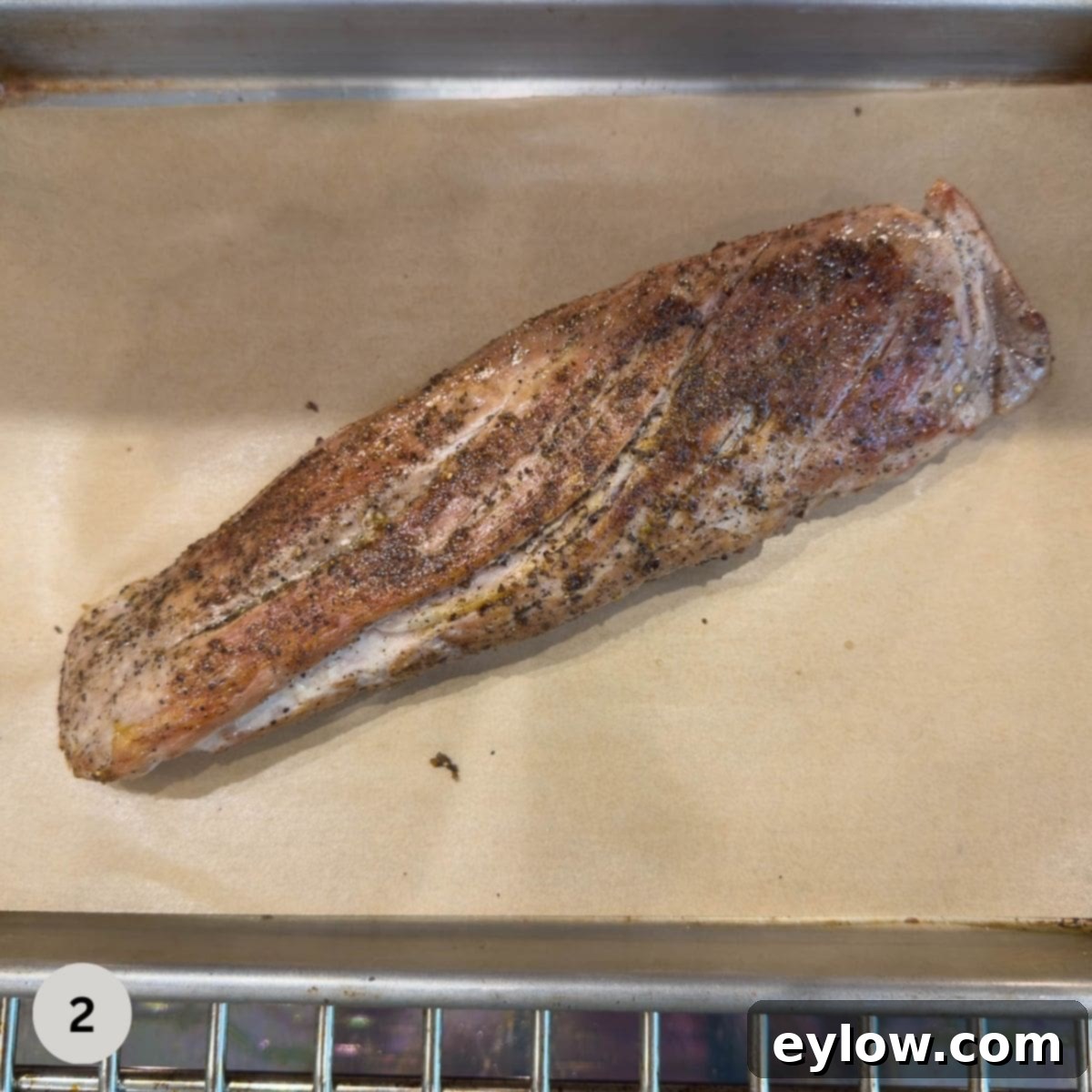
- Finish in the Oven: Transfer the beautifully seared pork tenderloin to a rimmed baking sheet lined with parchment paper. This parchment prevents sticking and makes for easier cleanup. Using a pastry brush, lightly add a little extra olive oil over the pork for added moisture and a lovely sheen. Place the baking sheet into your preheated oven to roast for approximately 10 minutes. The pork is done when an instant-read digital thermometer inserted into the thickest part reads between 140°F – 145°F (60°C – 63°C). Remember, the temperature will continue to rise slightly as it rests.

3. Crucial Sauce Start: DO NOT WASH THE PAN! The browned bits (fond) left at the bottom of the pan are packed with incredible flavor and are essential for creating our luxurious Dijon mustard sauce. We’ll use this pan to build the sauce directly, capturing all those delicious essences.
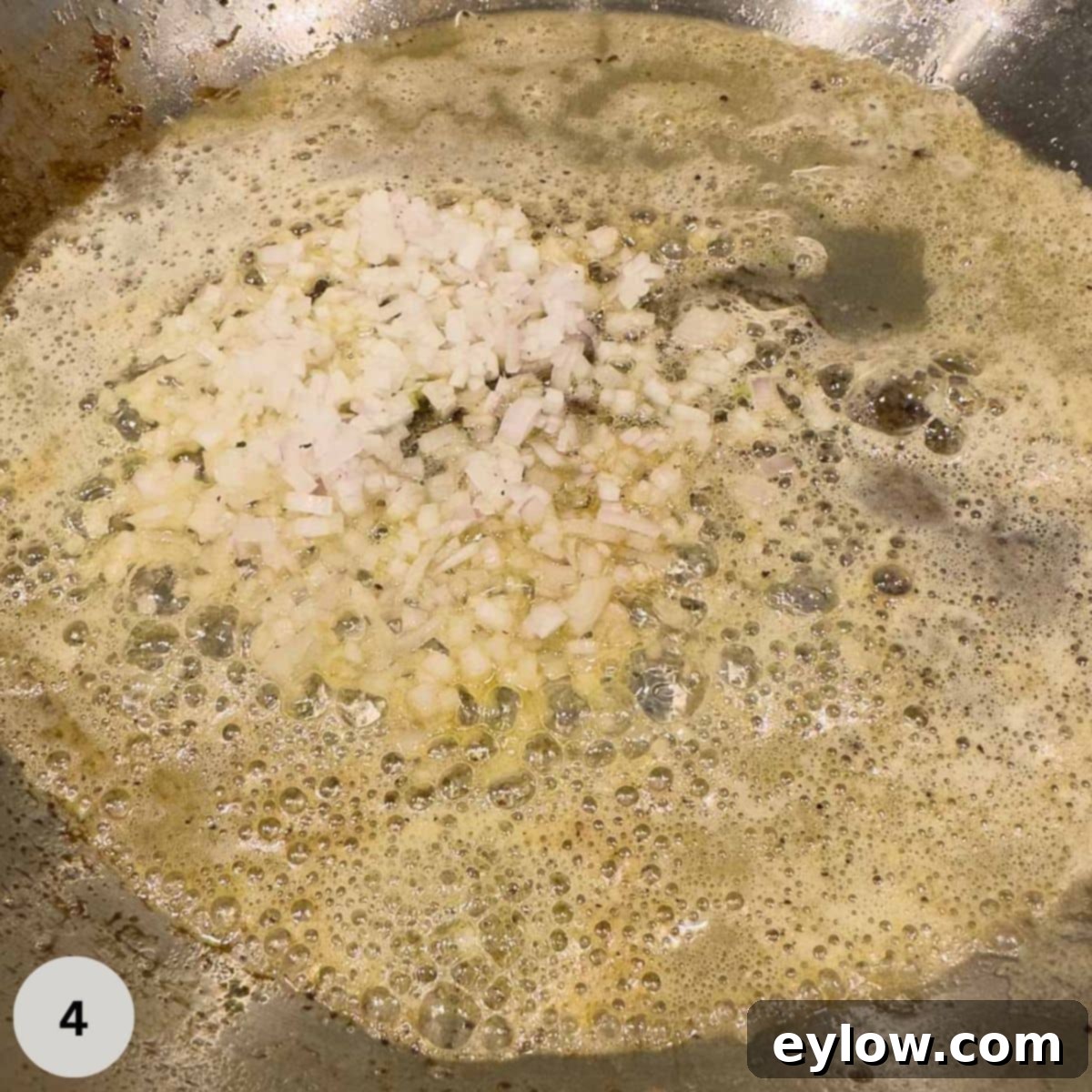
4. Build the Aromatics: Return the still-hot pan to medium heat. Add the unsalted butter and allow it to melt. Once melted, add the finely chopped shallots along with the fresh thyme (or dried, if using). Cook, stirring frequently and scraping the bottom of the pan with a wooden spoon to loosen and incorporate all the tasty browned bits. Sauté the shallots until they are softened and fragrant, typically 1-2 minutes.
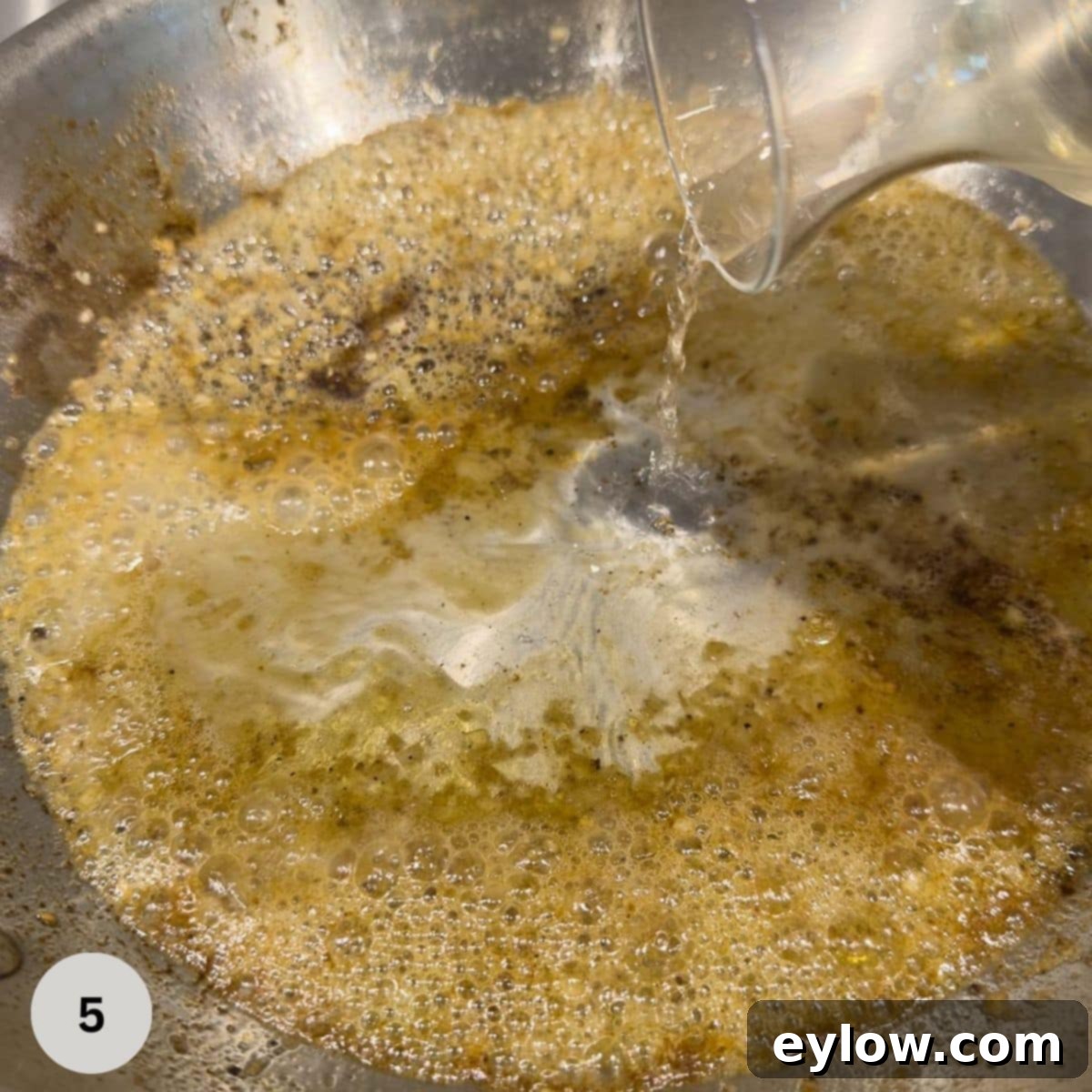
- Deglaze the Pan: Pour the white wine into the pan. This is where the magic of deglazing happens! Use your wooden spoon to vigorously scrape up all the caramelized, flavorful bits stuck to the bottom of the pan. These “fond” pieces dissolve into the wine, adding incredible depth and complexity to your sauce. Continue to cook, stirring, until most of the wine has reduced and cooked off, concentrating its flavor.

- Create the Creamy Sauce: In a separate small bowl, whisk together the heavy cream and both types of Dijon mustard (creamy and whole-grain) until smoothly combined. Pour this mixture into the pan with the reduced wine and shallots, continuing to stir constantly. The sauce will begin to thicken quite quickly as it heats.
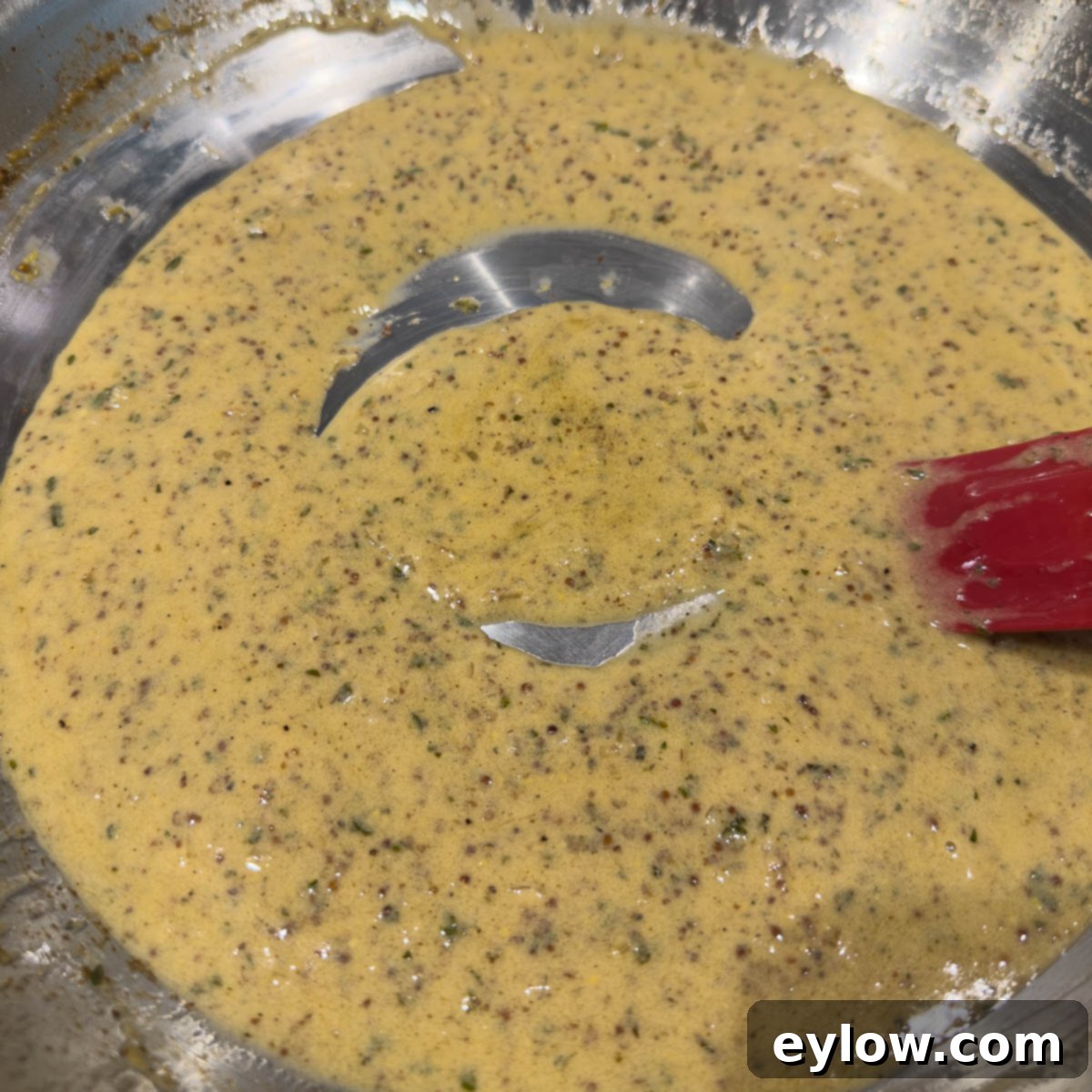
7. Serve and Enjoy: The sauce is done when it reaches your desired consistency – you should be able to draw a line through it with your spoon. Once the pork tenderloin is cooked, remove it from the oven and transfer it to a cutting board. Cover it loosely with foil and allow it to rest for 5-10 minutes. This resting period is crucial as it allows the juices to redistribute throughout the meat, ensuring a more succulent and tender result. After resting, slice the pork tenderloin (either on the diagonal for elegant presentation or straight across) and arrange it on a serving platter. Drizzle a generous amount of the warm, creamy Dijon sauce over the slices and serve the remaining sauce on the side. This dish is best enjoyed immediately!
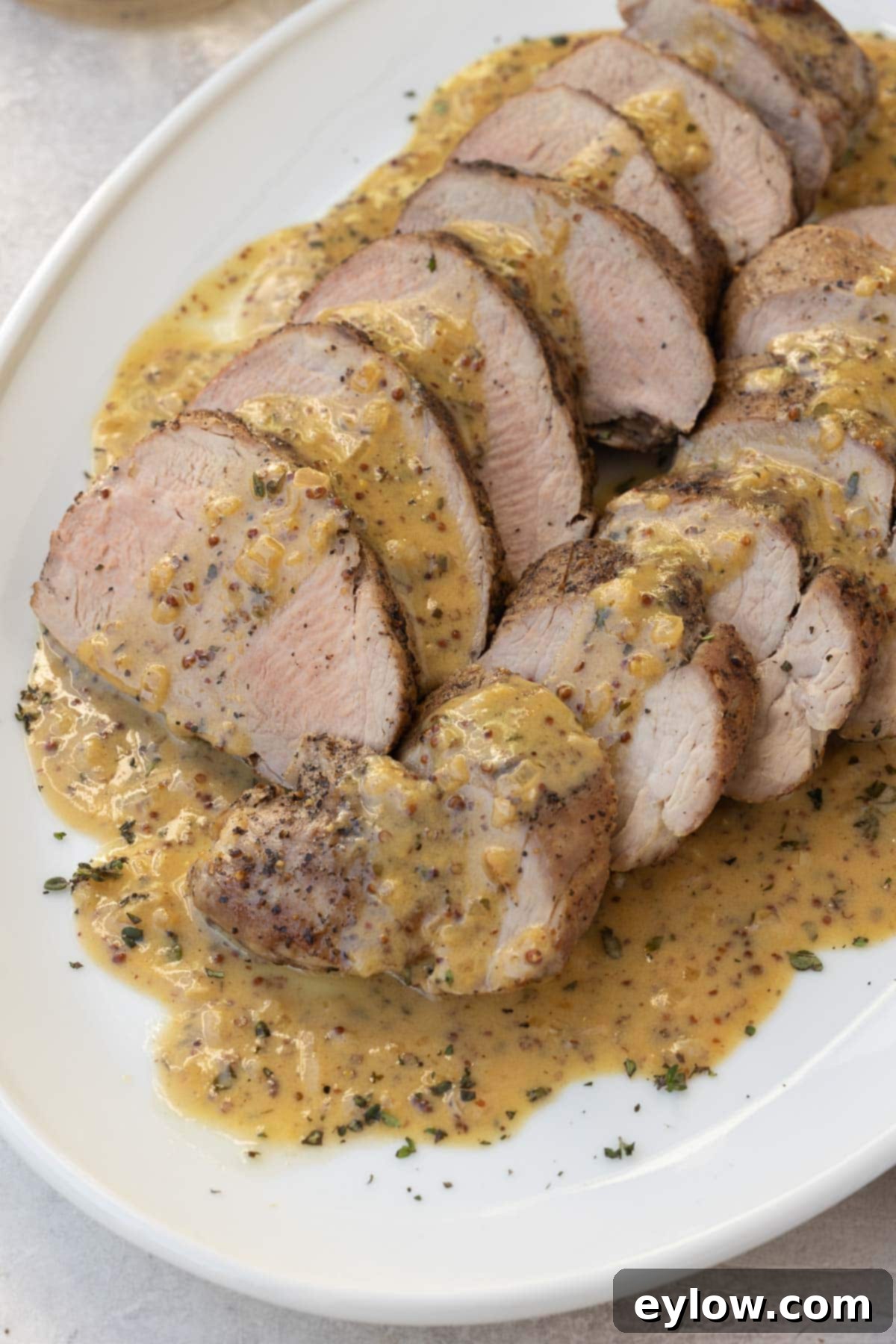
Chef’s Tip on Cooking Oil: Choose Wisely for Optimal Health and Flavor. When it comes to selecting cooking oils for searing and sautéing, making an informed choice can significantly impact both the flavor of your dish and your health. What should you avoid? It’s generally best to steer clear of highly processed seed oils or many common vegetable oils. These oils, such as soybean, corn, cottonseed, and canola oil, are often considered unhealthy because they can be inflammatory, frequently undergo extensive refinement with harsh chemicals, and are primarily derived from GMO crops. I primarily use high-quality olive oil for most of my cooking needs, even for moderate-heat searing, as it is more stable than often perceived. Coconut oil is another excellent option, particularly where its subtle tropical flavor complements the dish. For higher-heat cooking, ghee, a clarified butter, is a terrific choice. It’s a pure fat (devoid of water solids) and is naturally lactose and casein-free, making it suitable for many with dairy sensitivities. And for a truly neutral and clean option, I often reach for this healthy, sustainable neutral oil.
Delectable Serving Suggestions for Roast Pork Tenderloin
This roast pork tenderloin with Dijon mustard sauce is a star on its own, but it truly becomes a complete and satisfying meal when paired with the right side dishes. The versatility of pork tenderloin means it complements a wide variety of accompaniments. Here are some of my top suggestions to create a perfectly balanced and flavorful plate:
- Green Beans: A simple yet elegant choice. Try fresh green beans steamed or sautéed, then drizzled with a rich Balsamic glaze for a touch of sweetness and tang, or classic green beans almondine for added crunch and nutty flavor.
- Potatoes: Potatoes are a natural and comforting pairing. Explore these easy Dutch potatoes roasted with fresh herbs for a rustic touch, or indulge in creamy whipped sweet potatoes with rosemary for a hint of sweetness and earthy aroma. Mashed potatoes are also always a welcome addition, perfect for soaking up that delicious Dijon sauce.
- Broccolini: One of our absolute favorite green vegetables, this air fryer broccolini is an effortlessly quick and healthy side dish. It cooks in just minutes, yielding perfectly tender-crisp florets with a lovely char.
- Asparagus: Whether simply roasted asparagus spears with a squeeze of lemon or even a delicate bright green creamy asparagus soup served as a sophisticated starter, asparagus adds a fresh, seasonal touch.
- Roasted Vegetables: A medley of seasonal roasted vegetables is always a great accompaniment. Consider these vibrant roasted carrots with thyme, Brussels sprouts, bell peppers, or parsnips. Roasting brings out their natural sweetness and creates a wonderful textural contrast.
Of course, a crisp and refreshing good salad is always a welcome addition, providing a light counterpoint to the rich pork and sauce. Don’t forget some crusty bread to sop up any leftover sauce!
Recipe FAQs: Your Questions Answered
Here are some frequently asked questions about cooking pork tenderloin and making the perfect Dijon mustard sauce, ensuring your dish is always a success.
The key to incredibly moist pork tenderloin lies in two crucial techniques: the sear-and-finish method and precise temperature monitoring. Pan-searing creates a delicious crust and locks in juices, while finishing it in the oven ensures even cooking throughout. Most importantly, avoid overcooking! Pork tenderloin is lean, so it cooks quickly. It’s perfectly done when an instant-read digital thermometer inserted into the thickest part reads between 140°F – 145°F (60°C – 63°C). Remember that the internal temperature will continue to rise by a few degrees as the meat rests, covered with foil. Additionally, serving pork tenderloin with a flavorful sauce, like our creamy Dijon mustard sauce, adds extra moisture and richness, enhancing the eating experience.
Absolutely! Pan searing pork tenderloin is a highly recommended technique. It creates a beautiful, caramelized, golden-brown exterior, developing a depth of savory flavor through the Maillard reaction that simply roasting alone cannot achieve. Searing also helps to lock in the meat’s natural juices. After a quick sear on the stovetop, you’ll finish the pork in the oven for a short period (about 10 minutes at 375°F for a convection oven, or a few minutes longer in a standard conventional oven). This two-step process ensures both a delicious crust and a moist, tender interior.
Leftover roast pork tenderloin can be safely stored in an airtight container in the refrigerator for 3-4 days. It’s delicious served cold in sandwiches or salads, or gently warmed up. I love chopping up extra pieces and repurposing them for quick tacos, stir-fries, or adding to an omelet. Leftover Dijon sauce will be quite thick when chilled but is surprisingly good cold. If you wish to warm it, transfer the sauce to a glass container and place it in a small pan of water over low heat for a few minutes, stirring occasionally. If it separates slightly, a quick re-whisk will bring it back together to its creamy consistency.
While not strictly “necessary” in the sense that you could technically roast it entirely in the oven, searing pork tenderloin is highly recommended and contributes significantly to the dish’s overall flavor and texture. Searing creates a rich, browned crust that adds incredible depth of flavor and visual appeal, a process crucial for developing what chefs call “fond” – those flavorful browned bits in the pan that form the base of our delicious sauce. Skipping this step would result in a less flavorful exterior and a missed opportunity for building a truly exceptional pan sauce. Therefore, for moist, tender pork with maximum flavor, searing is definitely the way to go.
Explore More Delicious Pork Recipes
Pork is an incredibly versatile, healthy, and delicious meat that offers a multitude of culinary possibilities. From succulent ribs to elegant roasts and quick chops, there’s a pork recipe for every occasion and every cook. Discover some of our other favorite pork creations that celebrate this fantastic protein:
- Pistachio Crusted Pork Rib Roast
- Smoked Pork Tenderloin (pellet grill)
- Sour Cream Pork Chops Recipe
- 3-2-1 Ribs (Smoked Baby Back Ribs Recipe)
⭐️Did You Make This Recipe?
If you’ve had the pleasure of making this delicious roast pork tenderloin with creamy Dijon mustard sauce, please take a moment to share your experience! I truly appreciate your feedback and love hearing from you. If you absolutely loved this recipe and it became a new favorite, kindly consider giving it a 5-star rating! Your ratings and comments are incredibly helpful to other readers who are looking for their next fantastic meal.
📖 Recipe
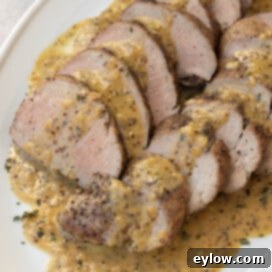
Roast Pork Tenderloin with Dijon Mustard Sauce
Sally Cameron
Pin Recipe
Equipment
-
12″ stainless steel or cast iron fry pan large enough to get the pork in to
-
Parchment paper
-
Rimmed baking sheet ¼ sheet or ½ sheet size.
Ingredients
Pork Tenderloin
- 1 ¼-1 ½ pounds pork tenderloin
- 1 ½ tablespoons olive oil or avocado oil divided use
- ½ teaspoon sea salt
- ½ teaspoon ground black pepper
Dijon mustard Sauce
- 2 tablespoons unsalted butter
- ¼ cup finely chopped shallot 1 medium shallot
- ⅓ cup dry white wine swap low sodium chicken broth
- 4 ounces heavy cream or heavy whipping cream ½ cup
- 1 tablespoon creamy Dijon mustard
- 1 tablespoon whole grain Dijon mustard
- 2 teaspoons fresh chopped thyme leaves swap ¾ teaspoon dried thyme
Instructions
Season the pork
-
Pre-heat the oven to 375°F (190°C). Line a rimmed baking sheet with a piece of baking parchment paper and set it near the stove, ready for use.
Carefully trim the pork tenderloin, removing any tough silver skin (which looks like a shiny, silvery membrane) and any significant excess fat. Pork tenderloin is typically quite lean, so this step is often minimal. Rub the entire tenderloin with a little olive or avocado oil (about 2 teaspoons from your measured amount) and generously sprinkle all sides with sea salt and freshly ground black pepper.
Sear and roast the pork
-
Heat your large, heavy-bottomed frying pan over medium to medium-high heat until it’s quite hot but not smoking. Add the remaining oil (about 1 tablespoon) to the pan, then carefully place the seasoned pork tenderloin into the hot pan. It should immediately sizzle upon contact.
Allow the pork to sear on all sides, turning it periodically with tongs or a spatula to ensure all surfaces develop a beautiful, golden-brown crust. This searing process usually takes about 5-7 minutes in total.
Once seared, transfer the pork tenderloin to the prepared baking sheet. Lightly brush with a tiny bit of extra olive oil for moisture and shine. IMPORTANT: DO NOT WASH THE PAN – leave all the delicious browned bits for the sauce.
Immediately transfer the baking sheet with the seared pork to the preheated oven. Roast for approximately 10 minutes, or until an instant-read thermometer inserted into the thickest part of the pork reads between 140°F – 145°F (60°C – 63°C). While the pork is roasting, proceed to make the Dijon mustard sauce using the same pan.
-
Once the pork is done roasting, remove it from the oven and transfer it to a clean cutting board. Tent it loosely with foil and allow it to rest for 5-10 minutes. This resting period is critical for the juices to redistribute, ensuring a tender and moist result. When the mustard sauce is ready, slice the pork tenderloin into thick medallions, either on the diagonal or straight across, arrange on a platter, and serve immediately with the luscious sauce.
Make the Dijon mustard sauce
-
With the same pan still warm (or return it to medium-low heat), melt the unsalted butter. Once the butter is melted and bubbling gently, add the finely chopped shallots and fresh thyme. Stir frequently, making sure to scrape the bottom of the pan with a wooden spoon or spatula to loosen and incorporate all the flavorful browned bits (fond) left from searing the pork. Sauté until the shallots are softened and translucent, about 1-2 minutes.
-
Pour in the dry white wine to deglaze the pan. Continue stirring and scraping, ensuring all the fond is incorporated into the liquid. Let the wine cook down and reduce by about half, which concentrates its flavor, for about 1-2 minutes. In a small bowl, whisk together the heavy cream, creamy Dijon mustard, and whole-grain Dijon mustard until smooth. Pour this mixture into the pan, stirring continuously. Continue to stir until the sauce thickens to your desired consistency – it should be thick enough to coat the back of a spoon, typically just a few minutes. Taste and adjust seasoning with salt and pepper if needed. Serve a generous amount of this creamy Dijon sauce over the sliced pork tenderloin, with extra available on the side for dipping.
Notes
Timing: The exact cooking time for your pork tenderloin will vary based on your oven’s calibration and whether you are using a convection mode. If you are using convection roast mode, as I often do, 10 minutes is usually perfect for achieving a beautifully cooked tenderloin. A standard conventional baking mode may require a little longer, typically an additional 2-5 minutes. Always use an instant-read thermometer for accuracy.
Testing for doneness: While it’s important to verify the meat’s internal temperature towards the end of roasting to ensure it’s perfectly cooked, be mindful that each time you open the oven door, you cause a significant drop in temperature. This heat loss can extend the roasting time by an additional 1-2 minutes, so try to check only once or twice.
